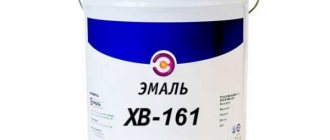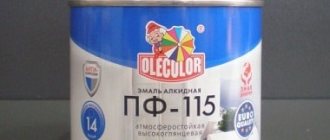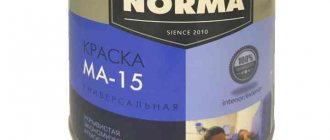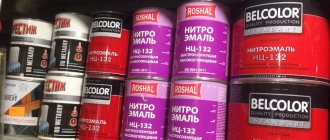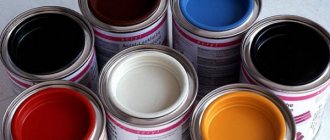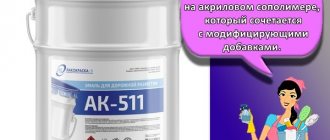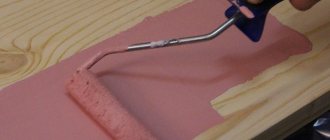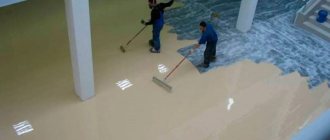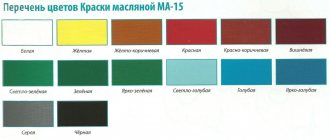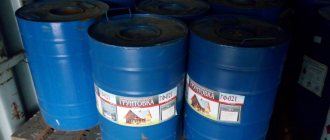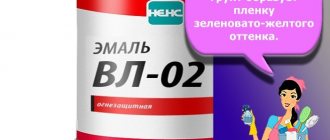GOST 6465-76 and GOST 926-82
PF-115 enamel is used for painting metal, wood and other surfaces exposed to weather conditions and for indoor painting.
Peculiarities:
- Enamels have high weather resistance, resistance to detergents and mineral oil. A coating consisting of two layers of PF-115 enamel applied to a prepared primed surface should retain its protective properties for four years, and PF-133 enamel for three years.
- The PF-115 enamel film is resistant to temperature changes from minus 50ºС to plus 60ºС.
- The enamel film has a high gloss.
Main characteristics:
- Single-pack materials based on alkyd resins.
- Almost any color at the customer's request.
- Application methods: pneumatic or airless spraying, electric field spraying, jet spraying, dipping, brush, roller.
- Drying time for enamels at (20±2)ºС up to stage 1 is 12 hours, up to stage 3 no more than 24-48 hours, depending on the color.
- When sanding, the enamel film should form a smooth surface and not stain the sandpaper.
- Enamels consumption per layer is 100-180 g/m2, depending on the color and method of application.
- The recommended number of layers is 2.
- The guaranteed shelf life for enamel PF-115
is 12 months, for enamel
PF-133
- 6 months from the date of manufacture. - Packaging: 10L and 20L buckets or 20L cans (10 kg and 20 kg), 50L, 100L and 200L barrels (50 kg, 100 kg and 200kg).
Preparatory work:
- The metal surface must be cleaned to a shine from rust and scale. The cleaned surface is dusted and degreased, for which it is wiped with a cloth soaked in white spirit and a dry cloth.
- Primers such as EF, PF, GF or others are applied to the prepared metal surface.
- It is possible to apply enamels directly to metal.
- The dry wooden surface is cleaned of grease, dirt, dust and old peeling paint. Sanding and dust removal are recommended. To improve adhesion to wood and reduce enamel consumption, you can coat a previously unpainted surface with drying oil and dry it before applying enamel.
Color:
- Before use, make sure that the enamel is well mixed and homogeneous throughout the entire volume of the container.
- If necessary, enamels can be diluted before use with solvent, white spirit (Nefras-S4-155/200), turpentine or a mixture of them in a 1:1 ratio by weight, but not more than 20% by weight of the enamel. For PF-133
no more than 30%. For painting in an electric field, the enamels are diluted with RE-4V or RE-3V thinner. The prepared enamel is applied to the primed or unprimed surface of the metal being protected with a brush, roller, pneumatic or airless spraying, spraying in an electric field, jet pouring, dipping at an ambient temperature from minus 5ºC to 30ºC. After the enamel layer has dried (24-48 hours at 20ºC), subsequent layers are applied. - To wash the instrument, you can use the solvents listed above.
- Store enamels indoors in tightly closed containers, away from direct sunlight and moisture.
Precautionary measures:
Materials are flammable! Do not work near open fire sources. Work should be carried out with good ventilation, wearing rubber gloves, using personal protective equipment. Avoid contact with respiratory and digestive organs. If the material gets on your skin, wash it with warm water and soap.
Keep away from children!
Specification in PDF format:
How long does acrylic paint dry on wood?
All about construction paints
How long does acrylic paint take to dry?
. is a question that is not entirely correct. To answer it, you need to understand, first of all, how the process of hardening of the binder takes place in this type of paint coating. Only after this will it become clear how to find out the more or less exact time it takes for acrylic paint to dry.
How does acrylic paint dry?
Firstly, to answer the question, how long does acrylic paint take to dry?
. First, you need to understand that acrylic paint does not dry on its own. Its binder contains a special hardener. Its task is to start a chemical reaction, due to which polymerization of the applied paint layer occurs.
It is also worth considering that the rate of polymerization is affected by the temperature at which this process takes place. Thus, it was experimentally found that the optimal temperature regime is in the range from +10 degrees Celsius to +100 degrees Celsius.
It is precisely because of such a wide range of optimal temperatures that it is impossible to accurately answer the question of how long acrylic paint takes to dry, but it is worth noting that the higher the temperature, the faster the paint coating dries.
Unfortunately, it is almost impossible to achieve sufficiently high temperatures, above +25 degrees Celsius, in domestic conditions. They can only be achieved in special painting booths. Inside such chambers, the initial drying of the paint occurs within just 30 minutes. But the complete process of hardening the paint coating does not end there. The entire polymerization process, even under ideal conditions, takes about a day.
How to choose?
Enamel is considered an ideal coloring agent for floor coverings, as it allows you to renew their appearance and provide the base with protection from negative influences and mechanical damage.
But in order for the floor to look beautiful after painting, it is important to choose the right type of enamel, which depends on the type of surface
For wooden floors, acrylic, oil and alkyd based enamels are most often chosen. In this case, the surface of the wood needs good preparation. To do this, it is leveled and coated with a protective primer.
Plank floors are often painted with oil enamel, as it is inexpensive and saturates the wood well. However, this composition takes a long time to dry and has a pungent odor, so painting work must be done in ventilated rooms. For rooms where there are large crowds of people, it is recommended to choose polyurethane paint, as the floors need protection from scuffs, scratches and damage.
As for acrylic dyes, they provide wood with a glossy shine and prevent the formation of mold and mildew. This type of enamel is very popular because it is presented in a chic color spectrum and is characterized by high quality. Most often, acrylic mixtures are used for painting coatings in supermarkets, shopping centers and shops.
Concrete floors are sometimes found in residential areas. They are considered durable, but to extend their service life, additional protection from abrasion and moisture is necessary. In addition, concrete can crack and be subject to mechanical damage.
At the same time, acrylic dye prevails over the epoxy option, since after finishing it the floor becomes shiny and beautiful.
Concrete coatings need to be painted in two layers, so this fact must be taken into account when purchasing enamel and purchased with a small margin. An epoxy mixture will also be a good dye for concrete, as it can withstand temperature changes. However, such material is produced in a small assortment of colors.
How and how to properly paint a wooden floor, see the following video.
Technical characteristics of paint PF-115
As already mentioned, the paint has a number of properties that, in this combination, are quite unique, which allowed the composition to withstand fierce competition and last on the market for more than half a century. At the same time, enamel is one of the most popular, which in itself is a unique phenomenon.
We show the main characteristics of PF-115 paint in the form of a table:
| Mass fraction of non-volatile substances,% | 49-70 |
| Surface gloss, % | ≥ 50 |
| Conditional viscosity at T=20 0C | 60 -120 |
| Drying time at 20 0C, h | ≤ 24 |
| Flexural elasticity | ≤ 1 |
| Hardness, arb. units | 0,15-0,25 |
| Impact strength | ≥ 40 |
| Film adhesion level, points | 1 |
| Covering power g/m2 | 60 – 100 |
| Water resistance | ≥ 2 |
| Oil resistance, h | ≥ 24 |
| Resistance to detergents, h | ≥ 15 |
| Consumption, kg/m2 | 0,1 – 0,18 |
| Flammability group | flammable |
| Smell | pronounced |
| Toxicity | moderate |
Due to its properties, PF-115 enamel requires careful handling, especially when used in enclosed spaces. Before work, it is necessary to check the functionality of the ventilation and the absence of open flame sources. It is also not recommended to use heat guns, either liquid fuel or electrically heated.
APPENDIX 3 Information
| Indicator name | Norm |
| 1. Specific volumetric electrical resistance, Ohm×m | 5 ´ 104 — 1 ´ 104 |
| 2. Dielectric constant | 6-11 |
APPENDIX 3.
(Changed edition. Amendment No. 5).
INFORMATION DATA
1.
DEVELOPED AND INTRODUCED by the Ministry of Chemical Industry of the USSR
2.
APPROVED AND ENTERED INTO EFFECT by Resolution of the USSR State Committee on Standards
Change No. 5 adopted by the Interstate Council for Standardization, Metrology and Certification (Minutes No. 20 of 01.11.2001)
Registered by Bureau of Standards MGS 3975
The following voted to approve the change:
| State name | Name of the national standardization body |
| The Republic of Azerbaijan | Azgosstandart |
| Republic of Armenia | Armgosstandard |
| Republic of Belarus | State Standard of the Republic of Belarus |
| The Republic of Kazakhstan | Gosstandart of the Republic of Kazakhstan |
| Republic of Kyrgyzstan | Kyrgyzstandard |
| The Republic of Moldova | Moldova-Standard |
| Russian Federation | Gosstandart of Russia |
| The Republic of Tajikistan | Tajikstandard |
| Turkmenistan | Main State Service "Turkmenstandartlary" |
| The Republic of Uzbekistan | Uzgosstandart |
| Ukraine | State Standard of Ukraine |
3.
INSTEAD OF GOST 6465-63 and GOST 5.820-71
4.
REFERENCE REGULATIVE AND TECHNICAL DOCUMENTS
| Designation of the referenced technical document | Number of paragraph, subparagraph | Designation of the referenced technical document | Number of paragraph, subparagraph |
| ; | , | ||
| ; | |||
| , | |||
| ; ; |
6.
The validity period was lifted according to Protocol No. 5-94 of the Interstate Council for Standardization, Metrology and Certification (IUS 11-12-94)
7.
EDITION (May 2004) with Amendments No. 1, 2, 3, 4, 5, approved in January 1979, June 1980, June 1985, April 1988, May 2002 (IUS 3-79, 8-80, 10-85, 7-88, 8-2002)
SAFETY REQUIREMENTS
6.1. PF-115 enamels of various colors are fire hazardous and toxic materials, which is due to the properties of the components included in their composition.
Maximum permissible concentrations, hazard classes of components according to GOST 12.1.005 and fire hazard characteristics according to GOST 12.1.044 are given in table. .
table 2
| Maximum permissible concentration of vapors in the air of the working area of industrial premises, mg/m3 | Hazard Class | Temperature, C | Concentration limits of ignition,% (by volume) | |||
| flashes | spontaneous combustion | lower | upper | |||
| Xylene | 50 | 3 | Not lower than 23 | Above 450 | 1,0 | 6.0 |
| Turpentine | 300 | 4 | 34 | 300 | 0,8 | 6.9 |
| White Spirit | 300 | 4 | Not lower than 33 | 270 | 1,4 | 6.0 |
| Solvent | 50 | 3 | 22-36 | 464-535 | 1,02* | — |
| Lead compounds | 0,01/0,005 | 1 | — | — | — | — |
| Chromium compounds | 0,01 | 1 | — | — | — | — |
* Lower flammability limit at a temperature of 25 ° C and a pressure of 101325 Pa (760 mm Hg).
Solvent vapors have an irritating effect on the mucous membranes of the eyes, upper respiratory tract and skin.
Lead compounds, being extremely dangerous, cause chronic intoxication, expressed in damage to the central nervous and cardiovascular systems, changes in the blood, gastrointestinal tract and other organs.
Chromium compounds irritate and cauterize the mucous membrane and skin, causing ulceration; When aerosols are inhaled, the cartilaginous part of the nasal septum is perforated. They also have a general toxic effect, affecting the gastrointestinal tract.
6.3. The production of enamels must comply with the safety rules for paint and varnish production, approved in accordance with the established procedure.
6.4. Production, testing and use of enamels must comply with the requirements of GOST 12.3.005 and GOST 12.1.004.
6.5. Persons associated with the production and use of enamels must be provided with special clothing in accordance with GOST 12.4.103 and personal protective equipment in accordance with GOST 12.4.011, GOST 12.4.068.
Personal respiratory protection equipment - in accordance with GOST 12.4.028, GOST 12.4.004 and GOST 17269.
6.6. Work related to the production and use of enamels is carried out in rooms equipped with local and general supply and exhaust ventilation in accordance with GOST 12.4.021, ensuring the condition of the air environment in accordance with GOST 12.1.005.
Fire extinguishing agents - sand, felt, foam fire extinguishers OHP-10, carbon dioxide fire extinguishers OU-2 and OU-5, foam installations, finely sprayed water - in accordance with GOST 12.4.009.
6.7. To protect the atmospheric air from pollution, air purification must be provided at gas treatment plants and monitoring compliance with maximum permissible emissions (MPE) in accordance with GOST 17.2.3.02.
6.8. Waste generated during equipment cleaning is disposed of in accordance with the procedure for accumulation, transportation, neutralization and disposal of toxic industrial waste.
Sec. 6. (Changed edition. Amendment No. 5).
How to paint galvanized steel?
For painting “galvanized”, the use of traditional oil and alkyd paints is not permissible, since as a result of chemical interaction with zinc they will oxidize, which will lead to deterioration of adhesion, and, as a consequence, to swelling, peeling and cracking of the paintwork.
Khimtek-Yar LLC recommends using the following paints and varnishes for painting galvanized steel:
1. primer VL-02.
2. enamel VL-515.
3. Primer-enamel YARFAST-0715.
When using complex coatings to protect galvanization to ensure high adhesion to the galvanized surface and good anti-corrosion properties, it is most advisable to use VL-02 primer in accordance with GOST 12707 as a primer layer.
Primer VL-02 is a mixture of two components - a base and an acid thinner. Both components are mixed immediately before application in a ratio of “base: acid thinner” = 4:1, the primer is allowed to sit for 30 minutes and then applied to the surface by brush, pneumatic or airless spray. If necessary, the primer is diluted to working viscosity with solvents 648, R-6, toluene or xylene.
VL-515 enamel is applied over the VL-02 primer coating. It is allowed to apply VL-515 enamel without prior priming, but the durability of the coating will be lower than when used in combination with VL-02 primer.
Before use, VL-515 enamel is thoroughly mixed and diluted to a working viscosity of 16 to 22 s using a VZ-246 type viscometer with a nozzle diameter of 4 mm at a temperature of (20.0 ± 0.5) °C with solvent 515.
Then the enamel is filtered through two to four layers of gauze. VL-515 enamels are applied to the surface by pneumatic spraying using any type of paint sprayer. Application by brush is allowed.
The use of primer-enamel YARFAST-0715 allows you to avoid preliminary priming of the galvanized surface with primer VL-02 or primers of other brands. Before use, the primer-enamel is thoroughly mixed until the consistency is uniform throughout the entire volume, then left for 10 minutes until the bubbles disappear.
If necessary, the material is diluted with xylene or petroleum solvent to working viscosity.
Primer enamel is applied to the surface to be painted at an ambient temperature from plus 5 to 30 ° C and a relative air humidity of no higher than 80% in one or several layers.
The recommended thickness of the dried coating for YARFAST primer enamels is 80–100 microns.
Important: if you use other brands of paint to paint a galvanized surface, you must remember that they must be chemically inert towards zinc in order to avoid damaging the integrity of the coating. When using two materials for galvanizing painting - primer and enamel - you must be sure of their compatibility with each other
When using two materials for galvanizing painting - primer and enamel - you need to be sure of their compatibility with each other.
Purpose and areas of application
Due to its high viscosity and excellent adhesion, the use of PF 115 paint is very wide.
The composition can be painted:
- tree;
- concrete;
- plaster;
- putty;
- brick;
- metal.
It is not suitable except for roofing work - when sheets of slate or tin are heated strongly, cracks may appear and the color may change greatly.
Enamel is used primarily for external work on structures located in the open air. It is used both as a monolayer coating and as part of multilayer coatings, in combination with primers, anti-corrosion and antiseptic impregnations, and insulating layers. Enamel does not have its own antiseptic and bactericidal properties, so when processing wood and walls made of brick or concrete in humid conditions, such additives are necessary.
PF-115 enamel has very high decorative properties - according to GOST 6465-76 it is produced in 22 colors and shades. In recent decades, manufacturers have offered modernized paint, which is available in almost all RAL colors. In this case, the color number from the catalog is indicated on the cans or barrels of paint. This is one of the few cases when it is preferable to buy paint made not according to GOST than standard. But it is necessary to take into account that this type of enamel costs more than usual due to the use of expensive dyes.
The high elasticity of the film, which can be obtained by painting surfaces in two or more layers (a single-layer coating is used only when updating a previously completed finish with the same paint, provided that there are no cracks or blisters on it) allows the use of PF 115 in completely different climatic conditions. The temperature range at which the finished coating retains its properties is incredible – 50…+60 0С. But the paint fully complies with the declared characteristics only if all technological rules for applying the coating layer are observed. We will tell you further how to use enamel correctly.
Applications and recommended paint schemes
Waterproof alkyd enamel PF 115 can be applied with any type of painting tool - brush, roller, spray. When calculating the amount of paint required, you must definitely take into account the characteristics of the surface to be painted and the color of the paint.
Concrete, brick, unsanded wood absorb paint quite intensively and its consumption will be greater than when covering planed wood, metal or previously painted surfaces.
Selecting the amount of paint by color
Depending on the color, the consumption of standard paint is within fairly large limits. At room temperature, to paint 1 m2 of the same type of unprimed surface you will need:
0.1-0.14 kg - white paints
0.05 – 0.06 kg – black paints
0.07 – 0.1 kg – blue paints
0.07 – 0.08 kg – brown paints
0.1 – 0.2 kg – red paints
The calculation is given for single-layer painting. When determining the real one, the number of layers is multiplied by the given figures and again multiplied by a factor of 0.9 - each subsequent layer uses less paint than the first. The second coat can be applied no earlier than 24 hours after completion of the previous coating.
Only perfectly dry surfaces, heated to a temperature of at least +5 0C, can be painted. It is optimal to carry out painting work using PF 115 in dry, windless weather at an external air temperature in the range of +15 ... +22 0C. In this case, the paint will maintain optimal viscosity, the solvent will not evaporate too quickly from the surface, and the risk of drips will be minimized.
The method of application also affects paint consumption. If you use a roller, it will be larger than a brush, and a sprayer may lead to some overuse of the composition. Also, the average consumption directly depends on the quality of preparation of the surface for painting and compliance with standard paint application schemes.
Features of application on different types of surfaces
Let's take a closer look at how to properly apply paint to various types of surfaces.
Metal
Painting begins after the primer has completely dried . To prepare a metal surface, use compositions VL-05, GF-021 and other types of metal primers compatible with pentaphthalic varnish. Structures with traces of corrosion are additionally treated with rust converters immediately before priming.
Special products will slow down the oxidative processes in existing foci, convert loose oxides into solids and prevent the appearance of new foci of rust.
Tree
The technical characteristics of PF-115 enamel allow it to be applied without priming, but in 2-3 layers. It is recommended to pre-impregnate the wood with fire retardants, antiseptics, fungicides, and other protective agents that are not part of the enamel.
Mineral bases
Plaster, concrete, brick can be painted without priming. It is necessary to thoroughly dry the surface before starting work . Enamel forms a dense vapor-proof film, so residual moisture in the pores of the base can cause cracking at low temperatures, provoke mold growth, etc.
Fresh concrete walls, foundations, and other structures can be painted no earlier than six months after completion of construction.
